
The Hofburg formed the original centre of the Habsburg court, where the Imperial family lived, worked and ruled (and ate 13-course dinners).
- Historical buildings, squares, parks & courtyards
- Walk around most of the outdoor area freely
- Houses some top Vienna experiences, like:
- Sisi Museum & Imperial Apartments
- Spanish Riding School
- Imperial Treasury & crown jewels
- Book a guided tour* of the Hofburg area
- See also:
Jump to:
- Intro
- Sisi Museum & Imperial Apartments
- Spanish Riding School
- Treasury & crown jewels
- Hofburgkapelle chapel
- Monument to Emperor Franz
- Neue Burg wing (and museums)
- Heldenplatz square (and attractions)
- Burggarten park (and attractions)
- Volksgarten park (and attractions)
- How to get there
What’s at the Hofburg?
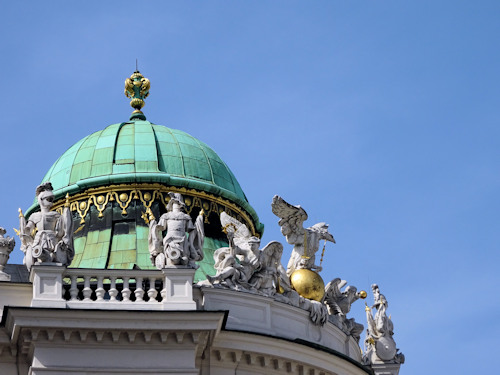
(Not the only place you’ll find gold and statuary)
Located in the old town at the centre of Vienna, the Hofburg area covers a collection of former imperial and court buildings occupied by the ruling Habsburg dynasty between the 13th and early 20th centuries.
The complex is not a standalone palace in the sense of a Versailles.
Instead, you get a series of opulent, interconnected buildings that grew from early life as the seat of the Duke of Austria in the 12th century to become the home and court of emperors.
Some parts now house visitor attractions, but others have administrative roles or serve as venues for conferences, trade fairs and even concerts*.
The offices of the Austrian president, for example, fill part of the Hofburg’s Leopoldine Wing. That tract dates back to the late 1600s (apparently, they’ve since upgraded the Wi-Fi).
You can wander around courtyards, parks and squares for free, but almost all the public attractions inside buildings need their own entrance ticket.
So just what are the attractions inside the Hofburg? We shall begin with…
Sisi Museum & apartments
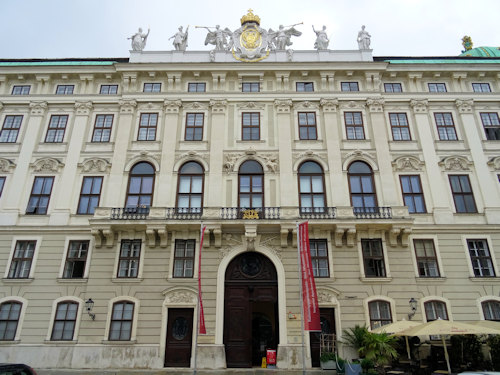
(Where empresses and emperors once lived)
The Sisi Museum examines the life and character of the iconic Empress Elisabeth (1837-1898). Its ticketed self-guided tour also includes access to the Imperial Apartments (Kaiserappartements), which take you through the rooms where Elisabeth and her husband Emperor Franz Joseph (1830-1916) lived.
In normal circumstances, the Sisi Museum tour would also include the Silver Collection (Silberkammer), which presents Imperial porcelain, crockery, cutlery, cooking utensils, and table décor.
However, the Silberkammer is closed for the foreseeable future for renovation work; check locally for reopening dates.
Many guided tours* of the Hofburg area focus on the Sisi Museum part, since this gives you behind-the-scenes insights into Imperial life.
Spanish Riding School
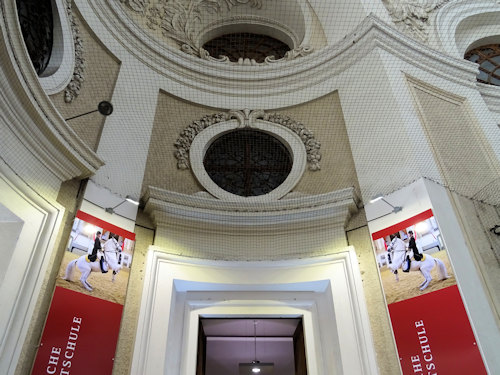
(Entrance to the Spanische Reitschule)
The Hofburg also hosts the baroque arena of the Spanish Riding School with the stables just over the road.
The school is home to the famous Lipizzaner stallions and possesses a rich history that dates back to the 16th century. The entrance to the visitor centre and 18th-century arena sits opposite the Sisi Museum entrance.
If you wish to see the horses, you have various options.
It’s relatively simple to find tickets for the public training sessions or formal performances, though you may want to book ahead to avoid disappointment. The school also does regular guided tours of the arena and stables.
Treasury & crown jewels
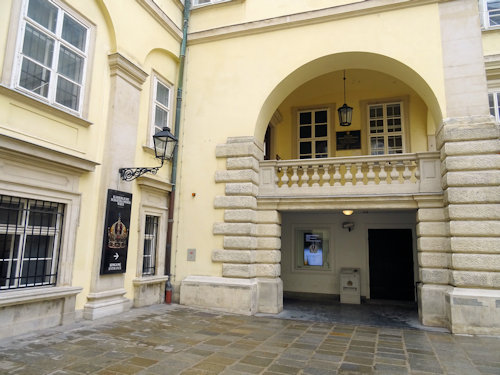
(Schweizerhof courtyard and entrance to the treasury)
The Schatzkammer or Imperial Treasury forms a standalone part of the Kunsthistorisches Museum group of state institutions.
Exhibits inside include various crown jewels, religious relics, and similar items collected by the Habsburgs.
The galleries house such baubles as the Habsburg imperial crown, the coronation robes and crown of the Holy Roman Emperor, a rosebush made entirely of gold, the 15th-century ceremonial sword of Emperor Maximilian I, and much more.
If Vienna was a treasure map, the Schatzkammer would have a great big X painted on its front door.
Hofburgkapelle
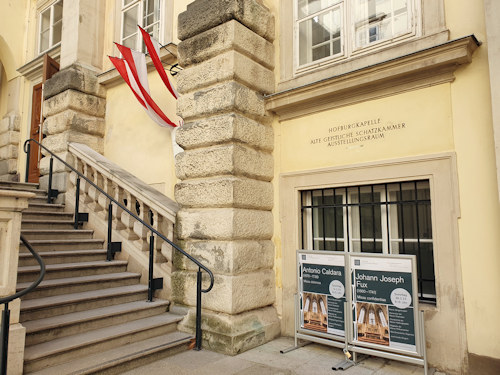
(Steps lead you up into the chapel from the Schweizerhof)
The Schatzkammer shares a courtyard with the 16th-century Schweizertor gateway and the Hofburgkapelle. The latter served as the Imperial Court Chapel for centuries, as you can tell from the Gothic style. The interior still includes original elements from over 600 years ago.
The chapel has public Holy Mass services most of the year on Sunday mornings, with the prestigious Wiener Hofmusikkapelle providing the liturgical musical accompaniment.
This choral and orchestral ensemble draws its members from the likes of the Vienna Boys’ Choir and the Wiener Philharmoniker orchestra.
Monument to Emperor Franz
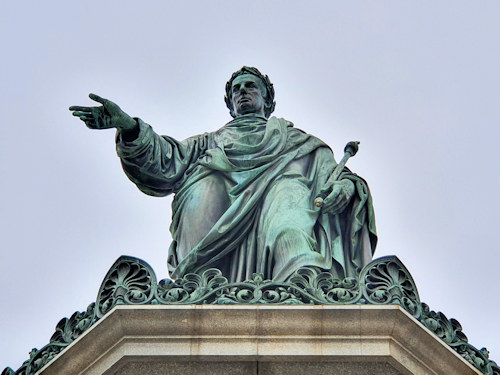
(Franz the double emperor)
The main courtyard within the complex itself has the huge 1846 monument to Emperor Franz II/I.
Franz’s double numerals come from holding two different Emperor titles: head of the Holy Roman Empire and head of the Austrian Empire. You’d think one emperor title would be enough but some people are hard to satisfy.
The Neue Burg
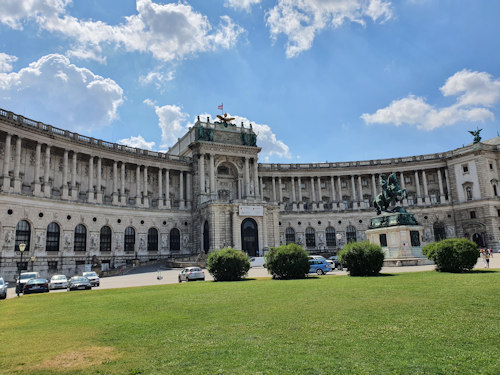
(View of the Neue Burg across Heldenplatz square)
The Neue Burg is a large wing that extends out from one side of the Hofburg and provides a home for numerous visitor attractions, such as:
- The National Library, though its astonishing state hall (genuinely mind-blowing) adjoins the Augustinerkirche church over on the Josefsplatz square side of the Hofburg
- The Ephesos Museum, a collection of ancient Greek and Roman artifacts
- The Weltmuseum, which takes you on a journey through the history and art of numerous cultures from around the world
- The House of Austrian History, a new addition to the museum landscape which covers events in the country post-WWI. This institution will move to the MuseumsQuartier in the coming years
- The Arms & Armour collection, which features row after row of tournament gear, medieval weaponry and prestigious armour designed to make it very clear that the wearer is more important than his opponent
- The Historical Musical Instruments collection, where you can see, for example, the very instruments used by the likes of Schubert, Liszt, Mahler, and other famous composers
Heldenplatz square

(The gates leading into Heldenplatz)
The huge Heldenplatz square in front of the Neue Burg has the Burgtor entrance gates, but is better known for its statues and installations:
- A large equestrian monument to Prinz Eugen von Savoyen, military leader and builder of the Belvedere palaces
- An equally large equestrian monument to Archduke Karl, whose claim to fame is being the first person to hand Napoleon a significant military defeat
- The Memorial to Victims of Nazi Military Justice, one of several WWII memorials and monuments in Vienna
The open space also hosts events like the Festival of Joy.
The Burggarten
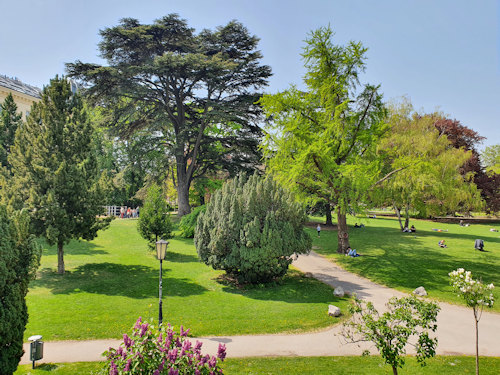
(We can thank Napoleon – indirectly – for this little green idyll)
The Burggarten park offers a little bit of green respite from the bustle of modern tourism. One end is the rear of the Neue Burg with its newly-renovated terrace. Other highlights include:
- The iconic Mozart monument and its sheet music themed flower bed
- The Imperial butterfly house, which occupies part of the Jugendstil greenhouses at the top of the Burggarten
The Volksgarten
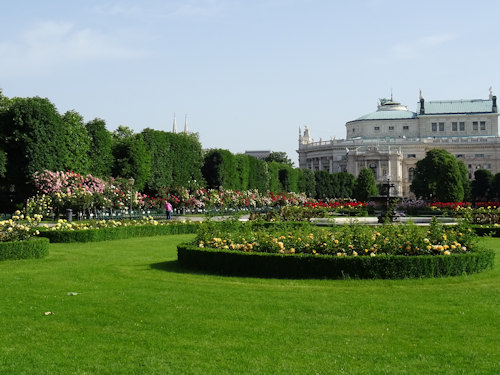
(The rose garden with the Burgtheater behind)
And the counterpart to the Burggarten on the other side of the Hofburg is the Volksgarten park.
This park has, for example:
- The best roses in Vienna (probably) in their own stretch of garden
- A Greek-style temple that doubles as a contemporary art gallery
- An almost-hidden memorial to Empress Elisabeth that even the Viennese tend to miss
- …and a monument to the famous Austrian writer Franz Grillparzer
How to get to the Hofburg
Let me put it like this…if you’re in Vienna, wandering around the compact centre, you’ll probably end up in the Hofburg by default.
The complex is huge and impossible to miss, as the map below demonstrates. It has various entrances but the main ones are on Heldenplatz and Michaelerplatz squares.
For specific public transport tips for individual locations, visit the links above. But if I might offer a tip…consider this walking tour route (actually Part 2 of my suggested self-guided walking tour of Vienna). Here a summary:
Start off at the Volksgarten park and walk on across to Heldenplatz (perhaps peeping round the back to see the Mozart statue). From Heldenplatz go on through the Hofburg proper to eventually emerge on Michaelerplatz square, which leads you down toward the lovely pedestrianised streets of the very centre.
This basic route takes you past the main highlights of the area.